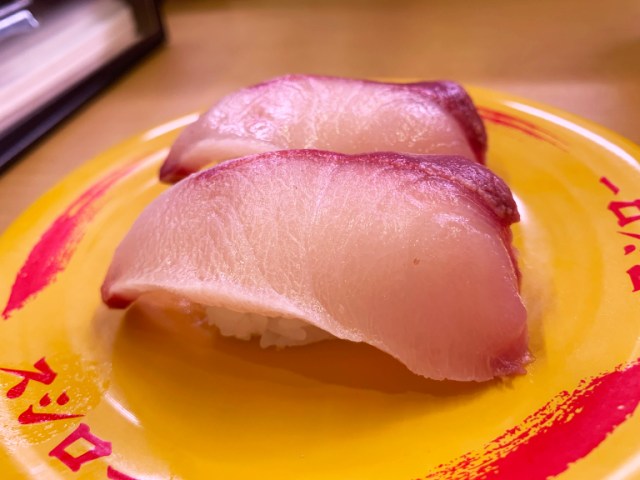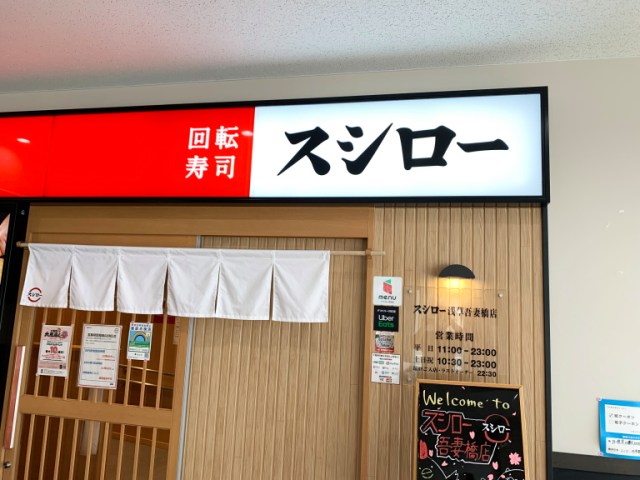
Same fish, same restaurant chain, but something is very different between Kanto and Kansai.
Basically speaking, the point of a chain restaurant is that no matter which branch you go to, you know what the food’s going to be like. For example, if you walk into a Lotteria in Tokyo and order a Tsukimi Rib Sandwich, you expect it to be the same as the Tsukimi Rib Sandwich customers get in Osaka, right?
So we were surprised when we kept hearing people say that the hamachi (yellowtail tuna) at Sushiro, one of Japan’s most popular conveyor belt sushi restaurant chains, is different in the Kanto region (east Japan) than it is in Kansai (the part of the country around Osaka). It wasn’t just online commenters we’d heard saying this, either, as our own Japanese-language reporter Seiji Nakazawa, an Osaka native now living and working in Tokyo, has eaten hamachi at both Kanto and Kansai Sushiro branches, and says “They’re clearly different.”
So what’s the difference? The texture. “In Kansai, Sushiro’s hamachi has a firm texture, with a bit of snap to it,” Seiji explains. “But here in Kanto, the hamachi has a tenderer texture, and it’s moister too.”
“That’s not just my personal opinion, either,” adds Seiji, who, as you might recall, is occasionally privy to insider information at Sushiro. He was able to confirm with the company that yes, their hamachi (and also their buri, another name for yellowtail tuna in Japanese) does indeed have different textures at the chain’s Kanto and Kansai restaurants, and the reason why is that there’s a difference in how much time passes between when the fish are caught and when they’re shipped to individual restaurants.
▼ A Kanto Sushiro
That might have you assuming that all of Sushiro’s yellowtail comes in through fishing ports in Kansai, and that they simply can’t ship it to branches in Tokyo as quickly as they can to restaurants in Osaka…but that’s not the case. Yes, for Tokyo branches slightly more time passes between when the fish is caught and when it reaches the in-restaurant plate, but this is completely by design, as Sushiro intentionally delays shipping in Kanto just a bit. That extra time results in a softer texture with more moistness, and those are the qualities sushi fans in Tokyo prefer in their hamachi, Sushiro says. Meanwhile, in Kansai, Sushiro says sushi fans are happiest when their hamachi is firmer and dryer, traits associated with faster distribution.
We should emphasize that even with the slower distribution for Kanto, Sushiro’s hamachi is extremely fresh and poses no health risks when eaten raw. And perhaps the difference between Kansai hamachi and Kanto hamachi is something not everyone will immediately notice, considering you’re unlikely to eat them both in the same meal. Still, plenty of people say they can taste a difference, and it turns out they weren’t imagining things, proving once again that when it comes to food, Kanto and Kansai often do things differently.
Photos ©SoraNews24
● Want to hear about SoraNews24’s latest articles as soon as they’re published? Follow us on Facebook and Twitter!
[ Read in Japanese ]
Follow Casey on Twitter, where he’s craving sushi right now (regardless of when you read this, the statement remains true).
[ Read in Japanese ]


 Which Japanese conveyor belt sushi chain has the best yellowtail sushi?【Taste test】
Which Japanese conveyor belt sushi chain has the best yellowtail sushi?【Taste test】 6 things you should try at Sushiro right now, according to staff who work there
6 things you should try at Sushiro right now, according to staff who work there There’s only one place in Japan where this kind of sushi isn’t red, but why?
There’s only one place in Japan where this kind of sushi isn’t red, but why? Japan super budget dining – What’s the best way to spend 1,000 yen at sushi restaurant Sushiro?
Japan super budget dining – What’s the best way to spend 1,000 yen at sushi restaurant Sushiro? What time of day gets you the best-tasting sushi at a revolving sushi restaurant?
What time of day gets you the best-tasting sushi at a revolving sushi restaurant? Foreigner’s request for help in Tokyo makes us sad for the state of society
Foreigner’s request for help in Tokyo makes us sad for the state of society Seaside scenery, history, and so many desserts on Yokohama’s Akai Kutsu【Japan Loop Buses】
Seaside scenery, history, and so many desserts on Yokohama’s Akai Kutsu【Japan Loop Buses】 Should you add tartar sauce to Japanese curry rice? CoCo Ichi makes diners an unusual offer
Should you add tartar sauce to Japanese curry rice? CoCo Ichi makes diners an unusual offer Japanese city loses residents’ personal data, which was on paper being transported on a windy day
Japanese city loses residents’ personal data, which was on paper being transported on a windy day McDonald’s new Happy Meals offer up cute and practical Sanrio lifestyle goods
McDonald’s new Happy Meals offer up cute and practical Sanrio lifestyle goods French Fries Bread in Tokyo’s Shibuya becomes a hit on social media
French Fries Bread in Tokyo’s Shibuya becomes a hit on social media Mt. Koya planning to instate visitor’s tax to cope with huge tourist numbers
Mt. Koya planning to instate visitor’s tax to cope with huge tourist numbers Red light district sushi restaurant in Tokyo shows us just how wrong we were about it
Red light district sushi restaurant in Tokyo shows us just how wrong we were about it Harajuku Station’s beautiful old wooden building is set to return, with a new complex around it
Harajuku Station’s beautiful old wooden building is set to return, with a new complex around it Kyoto’s 100 Demons yokai monster parade returns!
Kyoto’s 100 Demons yokai monster parade returns! Japanese ramen restaurants under pressure from new yen banknotes
Japanese ramen restaurants under pressure from new yen banknotes Studio Ghibli releases new action figures featuring Nausicaä of the Valley of the Wind characters
Studio Ghibli releases new action figures featuring Nausicaä of the Valley of the Wind characters New private rooms on Tokaido Shinkansen change the way we travel from Tokyo to Kyoto
New private rooms on Tokaido Shinkansen change the way we travel from Tokyo to Kyoto Tokyo Tsukiji fish market site to be redeveloped with 50,000-seat stadium, hotel, shopping center
Tokyo Tsukiji fish market site to be redeveloped with 50,000-seat stadium, hotel, shopping center Beautiful Ghibli sealing wax kits let you create accessories and elegant letter decorations【Pics】
Beautiful Ghibli sealing wax kits let you create accessories and elegant letter decorations【Pics】 Studio Ghibli releases Kiki’s Delivery Service chocolate cake pouches in Japan
Studio Ghibli releases Kiki’s Delivery Service chocolate cake pouches in Japan New definition of “Japanese whiskey” goes into effect to prevent fakes from fooling overseas buyers
New definition of “Japanese whiskey” goes into effect to prevent fakes from fooling overseas buyers Our Japanese reporter visits Costco in the U.S., finds super American and very Japanese things
Our Japanese reporter visits Costco in the U.S., finds super American and very Japanese things All-you-can-drink Starbucks and amazing views part of Tokyo’s new 170 meter-high sky lounge
All-you-can-drink Starbucks and amazing views part of Tokyo’s new 170 meter-high sky lounge More foreign tourists than ever before in history visited Japan last month
More foreign tourists than ever before in history visited Japan last month New Pokémon cakes let you eat your way through Pikachu and all the Eevee evolutions
New Pokémon cakes let you eat your way through Pikachu and all the Eevee evolutions Disney princesses get official manga makeovers for Manga Princess Cafe opening in Tokyo
Disney princesses get official manga makeovers for Manga Princess Cafe opening in Tokyo Sales of Japan’s most convenient train ticket/shopping payment cards suspended indefinitely
Sales of Japan’s most convenient train ticket/shopping payment cards suspended indefinitely Sold-out Studio Ghibli desktop humidifiers are back so Totoro can help you through the dry season
Sold-out Studio Ghibli desktop humidifiers are back so Totoro can help you through the dry season Japanese government to make first change to romanization spelling rules since the 1950s
Japanese government to make first change to romanization spelling rules since the 1950s Ghibli founders Toshio Suzuki and Hayao Miyazaki contribute to Japanese whisky Totoro label design
Ghibli founders Toshio Suzuki and Hayao Miyazaki contribute to Japanese whisky Totoro label design Doraemon found buried at sea as scene from 1993 anime becomes real life【Photos】
Doraemon found buried at sea as scene from 1993 anime becomes real life【Photos】 Tokyo’s most famous Starbucks is closed
Tokyo’s most famous Starbucks is closed One Piece characters’ nationalities revealed, but fans have mixed opinions
One Piece characters’ nationalities revealed, but fans have mixed opinions We asked a Uniqlo employee what four things we should buy and their suggestions didn’t disappoint
We asked a Uniqlo employee what four things we should buy and their suggestions didn’t disappoint Princesses, fruits, and blacksmiths: Study reveals the 30 most unusual family names in Japan
Princesses, fruits, and blacksmiths: Study reveals the 30 most unusual family names in Japan What’s the best type of sushi to end a meal on? Japanese survey picks the pieces
What’s the best type of sushi to end a meal on? Japanese survey picks the pieces Which Japanese conveyor belt sushi chain has the best scallop sushi?【Taste test】
Which Japanese conveyor belt sushi chain has the best scallop sushi?【Taste test】 Put down the soy sauce! We try a new “expert” way to season your sushi【Taste test】
Put down the soy sauce! We try a new “expert” way to season your sushi【Taste test】 Our reporter dishes on the differences between sushi from Ginza Kyubey and Sushiro【Taste test】
Our reporter dishes on the differences between sushi from Ginza Kyubey and Sushiro【Taste test】 Who’s got the best, cheapest one-person sushi delivery in downtown Tokyo? Mr. Sato investigates!
Who’s got the best, cheapest one-person sushi delivery in downtown Tokyo? Mr. Sato investigates! Which Japanese conveyor belt sushi chain has the best tuna sushi?【Taste test】
Which Japanese conveyor belt sushi chain has the best tuna sushi?【Taste test】 Which Japanese conveyor belt sushi chain has the best salmon sushi?【Taste test】
Which Japanese conveyor belt sushi chain has the best salmon sushi?【Taste test】 McDonald’s Japan made two almost identical commercials, with one tiny, touching difference【Vids】
McDonald’s Japan made two almost identical commercials, with one tiny, touching difference【Vids】 Sushiro is making sushi so delicious that even McDonald’s should be worried
Sushiro is making sushi so delicious that even McDonald’s should be worried Japan’s Sushiro revolving sushi chain stops revolving with conveyor-less food court branch
Japan’s Sushiro revolving sushi chain stops revolving with conveyor-less food court branch What should you use table salt for at a sushi restaurant? We asked a kaitenzushi maniac
What should you use table salt for at a sushi restaurant? We asked a kaitenzushi maniac Which Japanese conveyor belt sushi chain has the best aburi salmon sushi?【Taste test】
Which Japanese conveyor belt sushi chain has the best aburi salmon sushi?【Taste test】 Can you really drink Sushiro Japan’s limited-time-only drinkable cake? We find out
Can you really drink Sushiro Japan’s limited-time-only drinkable cake? We find out You can now get fugu, Japan’s poisonous blowfish, for under a buck at revolving sushi restaurants
You can now get fugu, Japan’s poisonous blowfish, for under a buck at revolving sushi restaurants Japan’s favorite super-cheap revolving sushi restaurant finally comes to Akihabara!
Japan’s favorite super-cheap revolving sushi restaurant finally comes to Akihabara! Which Japanese conveyor belt sushi chain has the best negitoro sushi?【Taste test】
Which Japanese conveyor belt sushi chain has the best negitoro sushi?【Taste test】 Which Japanese conveyor belt sushi chain has the best Prawn Tempura Sushi?【Taste test】
Which Japanese conveyor belt sushi chain has the best Prawn Tempura Sushi?【Taste test】
Leave a Reply